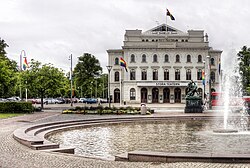History
The theater was originally founded to replace the Segerlindska teatern , and as such was known as Nya Theatern ('New Theatre') until 1880. The thirty-meter-high theater was inaugurated on September 15, 1859. During the first 60 years, this was mainly a dramatic theater featuring opera and operetta. In 1916, Stora Teatern became primarily a lyrical theater. [2]
On 17 March 2003, a lease agreement was signed between KIGAB (a company in the Higab group) and the Swedish Artists' and Musicians' Association (SAMI), which gradually extended until 2023, with the possibility of extension. KIGAB had the interior of the building renovated for SEK 60 million and created a number of concert, party and conference rooms as well as a restaurant which since 2008 has been known as Grill Del Mundo. [3] During the renovation, the building was also equipped with a recording studio, named Top Floor Studios, home to engineer and producer Jakob Herrmann. [4] The studio can record live performances from two of Storan's three stages. Since its reopening in 2003, SAMI has been running concert, conference and restaurant activities in the building.
This page is based on this
Wikipedia article Text is available under the
CC BY-SA 4.0 license; additional terms may apply.
Images, videos and audio are available under their respective licenses.

